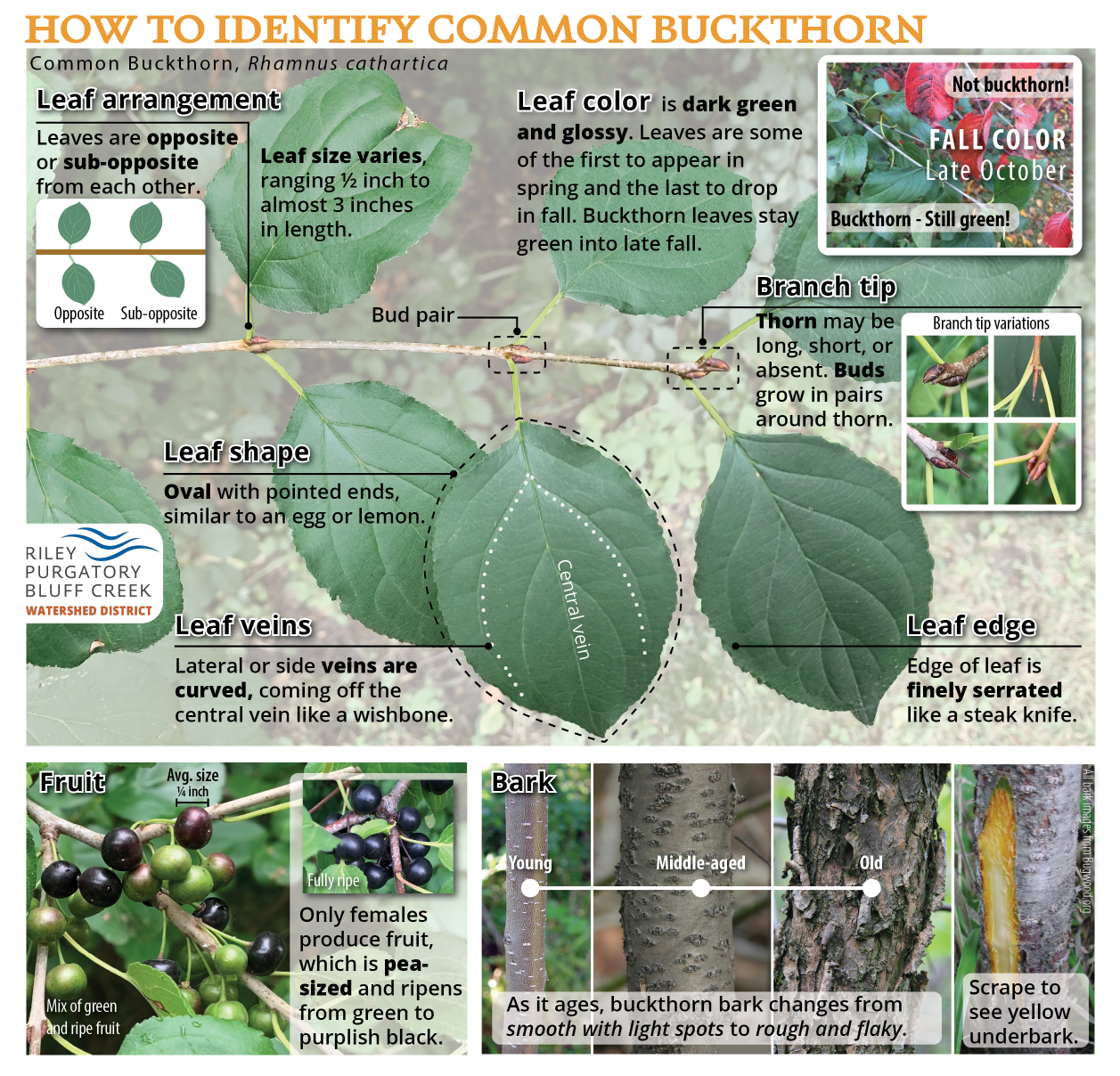Help Control Buckthorn
The Buckthorn problem
Buckthorn are invasive shrubs or small trees. Two species are found in Minnesota: Common Buckthorn (Rhamnus cathartica) and Glossy Buckthorn (Frangula alnus). Common Buckthorn is the species most often encountered on suburban properties.
Brought from Europe for hedges, buckthorn spread, forming dense thickets in forests and elsewhere. This highly invasive plant displaces native shrubs and small trees, destroying habitat for songbirds and other wildlife.
Management guide
Download our How to Beat Buckthorn guide to identification and management. You can also download individual pages:
- Cover page - How to identify common buckthorn
- Page 2 - How to identify glossy buckthorn
- Page 3 - How to control buckthorn - management options
- Page 4 - Native shrubs look-alikes
See the links under "City buckthorn programs & information" for resources available from your city within the watershed district.

Native Plants to Install After Buckthorn Removal
Some native plants will come back naturally after you remove buckthorn. But for the best chance at competing against buckthorn, researchers from the University of Minnesota recommend planting/seeding a combination of native grasses, wildflowers, trees, and shrubs.
- Native cool season grasses that establish quickly from seed and reduce light available for buckthorn seedlings. Seed is inexpensive and establishes quickly.
- Recommended species: Canada Wild Rye (Elymus canadensis), Bottlebrush Grass (Elymus hystrix), Virginia Wild Rye (Elymus virginicus), and Silky Wild Rye (Elymus villosus)
- Native wildflowers take some time to establish but are more shade tolerant that grasses and will eventually compete against buckthorn. Use a native wildflower mix (look for mixes designed to compete against buckthorn) or plant plugs for quicker establishment.
- Recommended species: White Snakeroot (Ageratina altissima), Virginia Waterleaf (Hydrophyllum virginianum), Tall Meadow Rue (Thalictrum dasycarpum), Red Columbine (Aquilegia canadensis), Brown-eyed Susan (Rudbeckia triloba), Lance-leaf Figwort (Scrophularia lanceolata)
- Native trees and shrubs that compete strongly against buckthorn. Species that hold onto their leaves late into autumn are most competitive. Consider caging/fencing off saplings to protect them from rabbits and deer.
- Recommended species: Red Elderberry (Sambucus racemosa), Black Cherry (Prunus serotina), Sugar Maple (Acer saccarum), Nannyberry (Viburnum lentago), and dogwoods (Cornus spp.)
Watch out for Garlic Mustard
Garlic Mustard is another woodland invasive plant. Download the factsheet on how to identify and control this species.
Seek and Destroy Garlic MustardResources from RPBCWD
- How to Beat Buckthorn - a guide to identification and management
- Stewardship Grant Program - grant money to help establish native vegetation after buckthorn removal
City buckthorn programs & information
- City of Eden Prairie buckthorn page
- Weed wrench (Uprooter) loan program for city residents
- City yard waste site for buckthorn disposal by city residents
- City of Chanhassen buckthorn page
- See this page for their weed wrench loan program for city residents
- City of Minnetonka
- Winning the Battle Against Buckthorn (StoryMap)
- Buckthorn workshop recording (3/14/2022) (video)
- City of Bloomington
Other resources
- A Guide to Forest Understory Revegetation to Help Manage Buckthorn and Other Invasive Plants (UMN CFANS May 2024)
- Managing Invasive Buckthorn - Whitepaper from UMN and MN Invasive Terrestrial Plants & Pests Center (June 2022)
- Buckthorn info - Minnesota DNR
- Controlling buckthorn: the who, what, where, when and how - University of Minnesota Extension
- Buckthorn: How can a shrub be so harmful? - Friends of the Mississippi River
- Cover It Up: Using plants to control buckthorn - University of Minnesota Dept. of Forestry Resources